by William Kherbek, Oct. 6, 2022
This article is part of our feature topic ’OIL.’
In the world of finance, the term “underlier” is used to describe a commodity that exists at the heart of tradeable securities known as “derivatives.” Oil, of course, is the great underlier, both in financial terms—“oil futures” can be traded to sometimes astonishing effect—but also as a literal underlier; it lies beneath the earth, and its extraction underlies almost every aspect of the global economy. The challenge of making visible something that is difficult to access in the physical world, and deliberately obscured in wider political and cultural discussions was where our discussion with Oliver Ressler began.
Ressler’s works operate in the space between visual art and activism. He is known for works that delve into the deliberately murky world of fossil fuel extraction and profit-making. Ressler’s practice also involves a curatorial and educational component, often bringing together artists and activists to discuss the relationship of climate breakdown to the world of cultural production. Such discussions, notably in ‘Barricading the Ice Sheets’ (2019-22), include indigenous artists with whom Ressler works and who provide often excluded insights into the brutalities that are glossed over, even in some climate activism. The harsh realities the world faces, both in terms of the rising global temperature, and the political and structural prices that must be paid are the subject of many of Ressler’s films and of our discussion.
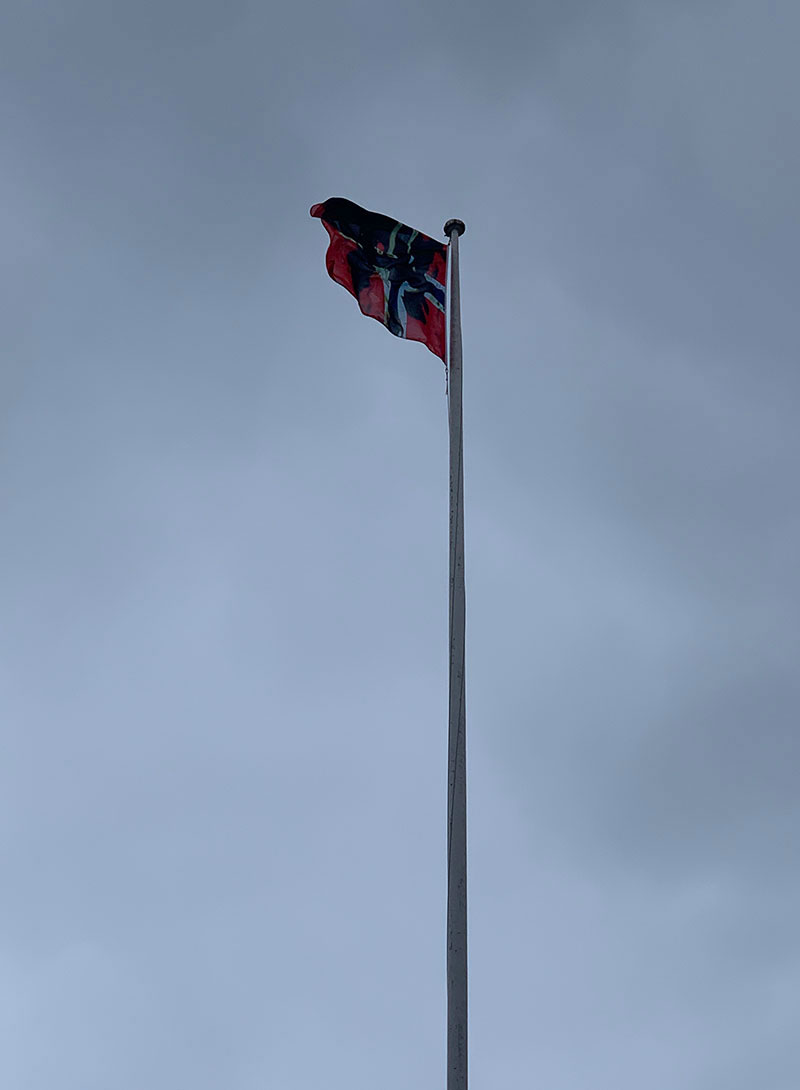
Oliver Ressler: ‘Oil Spill Flag,’ 2020, installation view // Photo by Tromsø Kunstforening
William Kherbek: How have you conceptualised or approached the “visibilisation” and representation of something as large as “oil” and “the fossil fuel industry” in making your work? It inevitably feels abstract to people, but, of course, nothing could be more concrete.
Oliver Ressler: While some of my work focuses on direct interventions against the fossil industry, such as blockades of sites of extraction or the blockade of Europe’s second largest coal harbour, located in Amsterdam, I have also carried out work that is more engaged in making visible the correlations that extractive industries prefer to hide from the public. Until recently only very few people knew that Geneva is the largest commodity hub in the world. It is exceptional, because there is no extraction, no mining, in Geneva. The majority of petroleum—for example, from Russia—is being traded through Switzerland. Of course this all happens without it ever reaching Swiss territory. Low taxes, banks specialised in supplying loans for commodity trade, and laws designed to keep the owners of the extractive industries invisible, are the main location factors. I addressed this in a film I made in Geneva in 2014. I was not interested in finding images as representation of oil or coal, but rather making visible hidden aspects of a system heavily dependent on fossil fuels, and highlighting those challenging and fighting it.
WK: Your work spans different media, but you’ve spoken about video as being one of your favoured media in terms of its accessibility and narrative qualities. Could you speak about how your choices of media are tied to the themes you seek to explore in your work? Do you see a specific role for art in conveying non-aesthetic information in the current corporate media climate?
OR: Television has transformed in a way such that it has become increasingly difficult to use it as a vehicle for progressive content and experimental formats. In the 1960s and ‘70s, filmmakers such as Harun Farocki, Peter Watkins or Jean-Luc Godard still could fund some of their radical work through TV. This appears impossible nowadays.
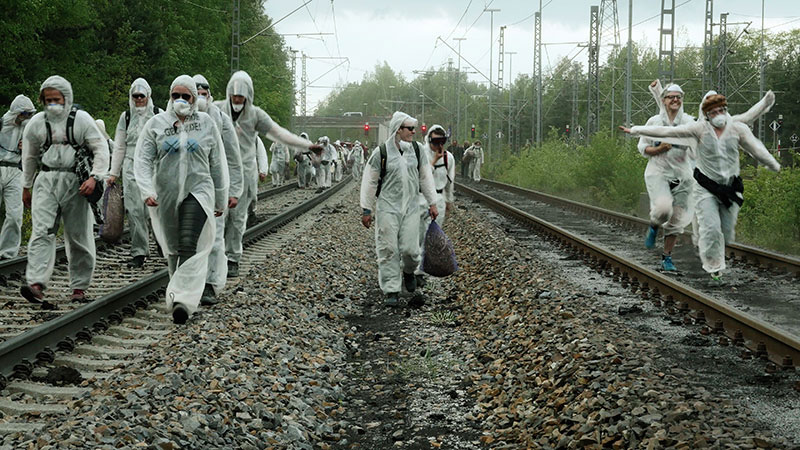
Oliver Ressler: ‘Everything’s coming together while everything’s falling apart: Ende Gelände,’ 2016, video still, 12 min., 4K // Courtesy of the artist; àngels, Barcelona; The Gallery Apart, Rome
Collaborating with television producers usually means losing control over the work in terms of content, form and distribution. The situation in print media is not that different, even though there are still progressive magazines. There are frequently reviews about my exhibitions and films in the media, but the people writing those reviews aren’t paid well enough to have the chance to really invest in writing something substantial. Also, there is not enough space for longer texts. This is really a shame. Sadly, my work gets most media attention when there is something media see as a scandal, as was the case when YouTube shut down my channel last year, or the controversy about my “Oil Spill Flag” in Norway in 2020.
My work is carried out in different media. I work in public spaces as well as make installations, photographic work, drawings, and sculptural works. Additionally, I organise public programmes, round-tables or curate shows. Some of these activities will be seen as art, others not. I am not so much interested in the boundaries, and I try to develop formats that function well in their specific contexts.
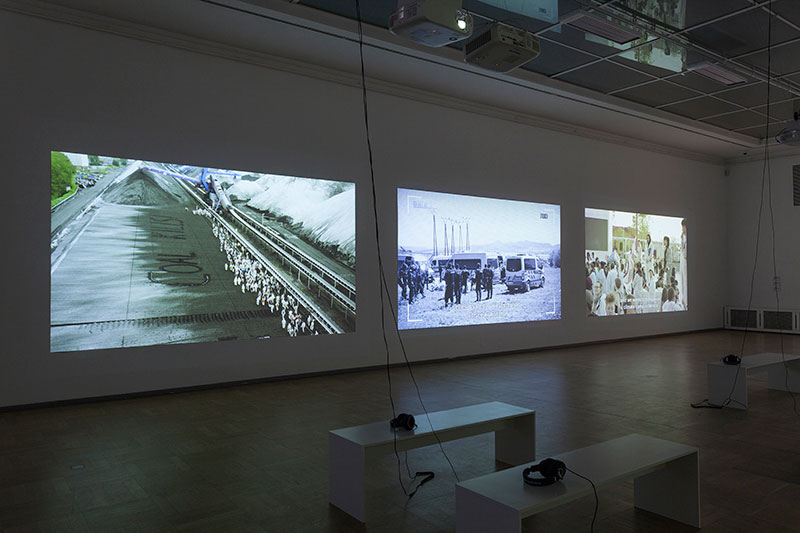
Oliver Ressler: ‘Everything’s coming together while everything’s falling apart,’ 2016-20, 6-channel video installation, 4K, in ‘Barricading the Ice Sheets,’ Tallinn Art Hall, Tallinn, 2022 // Photo by Paul Kuimet, courtesy of Tallinn Art Hall
WK: Oil is also understandable as a kind of medium, in terms of production and transport of course, but also in the sense of conveying ideas as a funding entity for information media and art, for example sponsorships of the Tate and other galleries. Do you have any thoughts about the ways oil has been literally inscribed into the history of western art?
OR: I think the images created by the US film industry after the end of the Second World War—road movies with fast cars driving through the desert—and art such as Colour Field Painting or Land Art both produce images that stand for conquering spaces. They are an expression of freedom and unlimited growth. In times of climate breakdown and social upheaval such ideas do not only appear outdated, but also ridiculous. They are an expression of the previously anticipated unlimited availability of energy, primarily petroleum. Brett Bloom’s work on “petro-subjectivity” or the exhibition project ‘Oil – Beauty and Horror in the Petrol Age’ at Kunstmuseum Wolfsburg give great insight into this interconnectedness.
The collective Liberate Tate is a good example where art and activism merge and go beyond solely criticising art institutions, but also in initiating year-long actions that ultimately led toward the Tate’s decision to give up BP’s sponsorship. So, it actually shows that with a specific agenda and collective action we are able to change the existing reality.
WK: You often work with other artists, some from indigenous backgrounds. Could you speak about the ways you’ve engaged them and their communities and the perspectives you’ve gained about extractive industry and climate justice in working with them?
OR: Last year I curated a show on artists who carry out artworks as part of climate justice movements. The exhibition ‘Overground Resistance’ (2021) was shown at frei_raum in Museumsquartier, Vienna, and new iterations of the exhibition will take place at NeMe Arts Centre in Limassol, and CAC Centro de Arte Contemporáneo de Quito in Ecuador later this year.
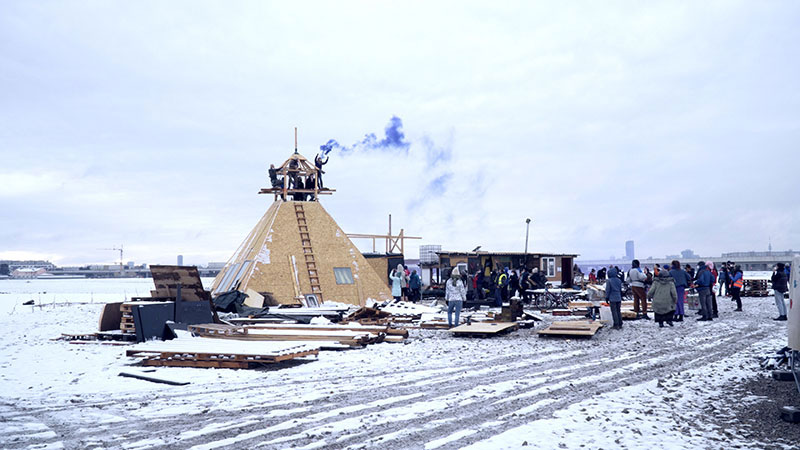
Oliver Ressler: ‘The Desert Lives,’ 2022, video still, 55 min., 4K // Courtesy of the artist; àngels, Barcelona; The Gallery Apart, Rome
From the very beginning it was clear that artists from an Indigenous background would play a crucial role. Indigenous peoples were and are at the centre of fighting colonialism, extraction, and the neoliberal capitalism that destroys their livelihoods. For them, the ecological and social crisis is nothing new; it started more than 500 years ago with the invasion by Europeans, and continued through subsequent genocide and ecocide. They have a huge burden to bear and experience shockingly little support from the rest of us. In ‘Overground Resistance,’ four self-described indigenous artists were included, from Mapuche Nation (Chile), the Standing Rock Sioux Tribe (US), the Marshall Islands, and Greenland. Indigenous peoples also speak in several of my films and multi-channel video installations; I cannot imagine doing the work I am doing without including their voices.
WK: In your workshop based on ‘Barricading the Ice Sheets,’ you mention probably the most crucial question about the relationship between climate and art: how can an insular world like the art world actually have a meaningful impact on climate discourse? How do you feel like this gap between intention, awareness, and outcome can be bridged by artists who are often personally very invested in climate concerns?
OR: I have problems speaking about “the art world” because as I see it, it consists of worlds that are very different from each other. Sometimes they do not even overlap, and they also do not share the same level of awareness or criticality. There are artists and curators flying around from art fair to art fair, obedient workers supplying trophies for an upper class. And there are others, heavily invested in establishing connections to critical organisations and social movements, who can be seen as allies in a struggle against climate breakdown.
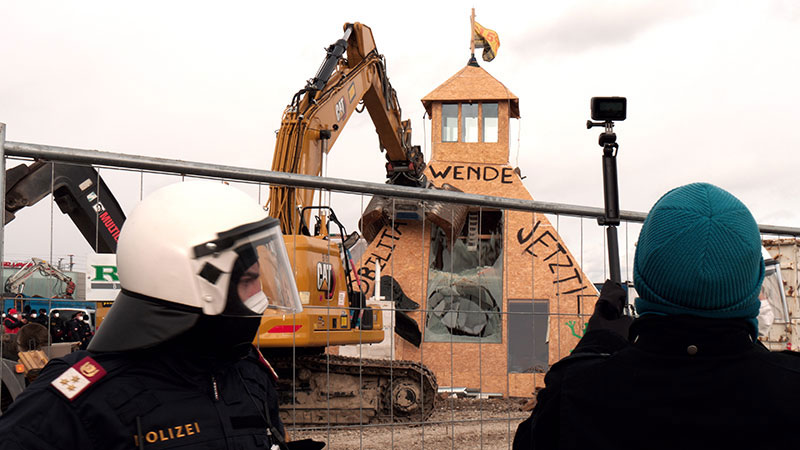
Oliver Ressler: ‘The Desert Lives,’ 2022, video still, 55 min., 4K // Courtesy of the artist; àngels, Barcelona; The Gallery Apart, Rome
WK: One of the most annoying, but ubiquitous, issues faced by campaigners for climate justice is the charge of “hypocrisy” (“You say you’re a climate activist, but I see you burn fossil fuels in winter to keep warm…” type arguments). How do you feel that art as a form of expression can challenge these and other traditional forms of argumentation and expectation?
OR: I think we have to fight this liberal climate propaganda that puts the individual at the centre of responsibility for climate breakdown. Capitalist structures bring forth monopolies and powerful transnational corporations limit our options. As someone who rents, you have no possibility of choosing your home’s heating system. In an area without public transport, you may have no other option than to drive. Therefore, I object to the term “Anthropocene,” which targets the human as responsible for ecological degradation. As theorists such as Jason Moore suggest, the term could be replaced by “Capitalocene,” which identifies capitalism as the main factor for this destruction. I am not saying individual responsibility does not exist, not at all. But only blaming the “silly,” “greedy” and “uneducated” individual serves to veil corporate responsibility and systemic problems. I think art can be used to amplify alternative views. Isn’t it the role of art to think beyond what already exists?
Artist and Exhibition Info
Tallinn Art Hall
‘Barricading the Ice Sheets’
Exhibition: Aug. 27–Nov. 6, 2022
Admission: € 8,– (reduced € 4,–)
kunstihoone.ee
Vabaduse väljak 6, 10146 Tallinn, Estonia, click here for map



















